I don’t like to think about it, but if I were to fly way up into the sky, I would see nothing but clouds and nigh-indiscernible specks of earth far beneath my feet. The thrill of flight would come into conflict with the struggle to remain aloft. Even the wide-open air might grow stale once I’ve realized it’s all I can espy in every direction.
But what if I’m the first to fly? I’m the only one who can do it. And I do it courtesy of a big, beautiful bird. And I’m on an important quest, and everywhere I go, the locals are essentially aliens, and they regard me as such until I prove I’m a pretty cool guy.
The Legend of Zelda: Skyward Sword HD is a game about pioneering in a strange world where nobody knows your name. But it’s also an oddly empty world, owing in large part to the relative blandness of its skies but also to — and this is the irony of ironies — its overly dense spin on Hyrule. How can a game packed with puzzles frequently come across as so bland and empty? Yet Hyrule also feels appropriately foreign. However, a few good friends go a long way toward making us care about a damsel in distress and the biggest Bigfoot we’ll ever see. (And see again. And again. And again.)
Skyward Sword is often at odds with itself. Its identity is never entirely clear because, for all the things it does well, there are enough asterisks attached that the whole thing turns into a bit of an apartment rental contract. Many have even said it’s the most flawed 3D Zelda game. They might be right.
Despite all this, people celebrate Skyward Sword for its well-told story, numerous likable characters, and heaping helpings of whimsy inherent to the franchise. So what can be said of Skyward Sword HD, this revamped endeavor to bring the game from past into present and future? I dare say It soars.
Skyward Sword begins in Skyloft, where a young man who loves to sleep as much as my cat does (she’s like 65 in human years, what’s your excuse, Link?) prepares to participate in a traditional bird-riding ceremony. The winner gets to spend time with Skyloft’s most eligible bachelorette, a harp-playing young lady named Zelda, but before Link can even ride, a guy almost as broad as he is tall, Groose, ties up Link’s Loftwing to steal Link’s spot. Groose compliments his pompadour and looks like a fading 1970s glam rocker if they had stuck a spike in their hair and auditioned for a role at the Renaissance Festival. His two sidekicks — both look dead inside, and one looks sort of like Kamille Bidan — follow Groose wherever he goes. Groose wishes Zelda looked at him and saw a stud, not a dud. It’s all very dumb. I love Groose.
In the original release, it wasn’t unreasonable for players to feel suffocated early on by the sheer number of tutorials shoved every which way. Many of these felt superfluous. Learning how to run would have been better if the controls were introduced in a non-intrusive manner. Skyward Sword HD‘s development team took this and nearly every tutorial-related complaint to heart, which transforms fan-panned candlestick companion Fi from fatally chatty to a faithful friend.
I always liked Fi. She has some pretty snippy things to say from time to time, and who doesn’t enjoy the company of a blue woman with snark in her waxy veins? Most players, it turns out. Understandable. Fi’s funny lines were drowned out by the constant reminders that you’re in a dungeon, that a puzzle needs to be solved (and she’ll give you hint after hint without you asking), or that you’ve been playing for a long time… it was pretty bad. Almost as bad as the game reiterating each rupee type’s value and every item definition anytime you reload your save. Really, does it matter if you can’t remember that a red rupee is worth 20 green rupees 50 hours into the game?
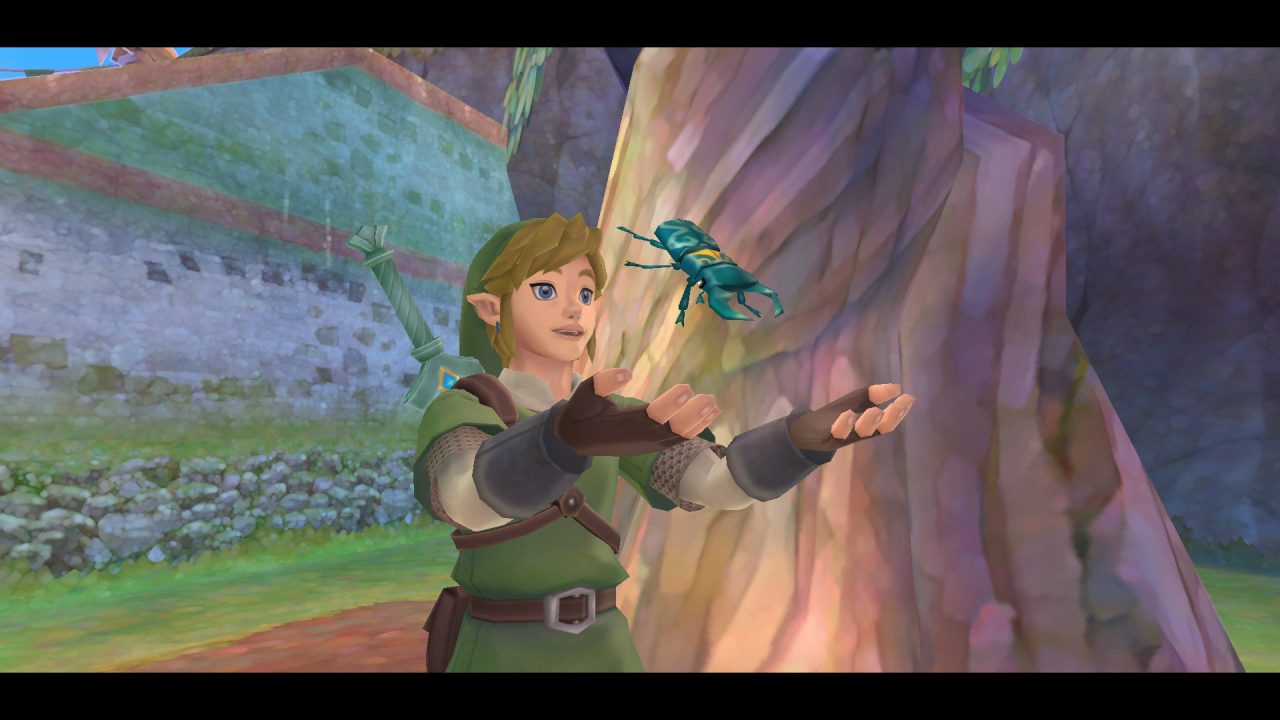
After the Loftwing ceremony is over, the skeletal structure of a Legend of Zelda plot begins to materialize. Zelda’s in trouble, a friend assists you, and pertinent tales from the past slowly reveal themselves as a prophetic tapestry roughly in line with the bleakness of current events. A few noteworthy twists also help establish this as canonically the first Zelda game in the timeline (even if this doesn’t appear to be the first great conflict, nor is this necessarily the first Link Thoughts differ on the matter).
Reading a summary of Skyward Sword‘s story, however, would do it a grave injustice. Similar to how The Legend of Zelda: Majora’s Mask is revered due to the diverse and dark-lit denizens of Termina, Skyward Sword‘s fans hold its narrative dear for its principal cast. Zelda may be woefully in need of rescuing again, but her actions throughout the game’s early stages give her a degree of agency alongside a charming personality. Groose’s personal journey is a hallmark of growth, determination, and eventual heroism. The villainous Ghirahim is a memorable presence from the moment he licks Link until his last spiteful words. And as for Link himself, this is the most personality he’s ever had. Though he remains a blank slate in some ways, he eclipses even The Wind Waker‘s Link in emotionally charged facial expressions. This capable conveyance is enhanced with Skyward Sword HD. Character expressions are sharp, crisp, and easier on the eyes than they were in the days of the Wii original.
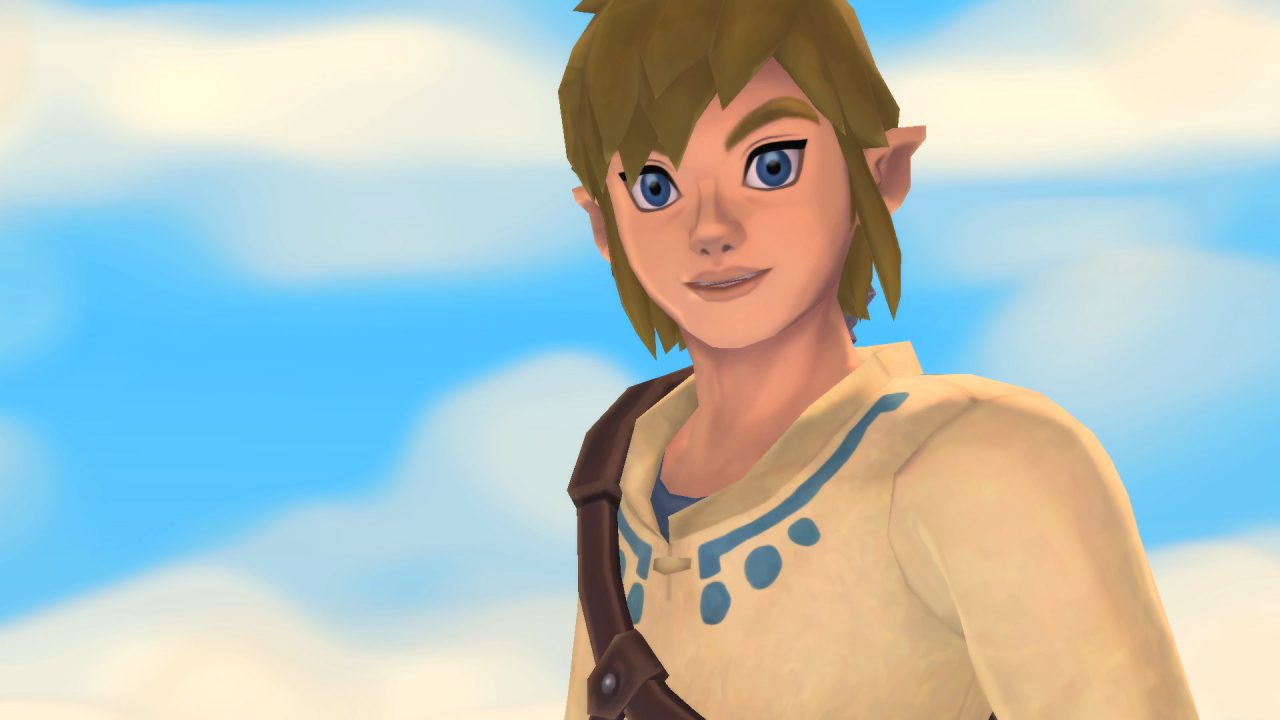
To that end, let’s talk graphics. We’re still well within the realm of positives here, but the cracks begin to show. Skyward Sword HD is vivid, with alluring blue skies, striking green forests, a volcanic region that practically boils through the TV screen — you get the gist. But something is missing that, for all its uglier edges, could be found in spades back in 2011.
The original employed a painterly approach to its visuals to mask aging hardware; iffy draw distances became intriguing splotches of color at the outermost layer of Link’s view, and areas that might have been veritable nests of aliasing were “painted over.” This clever aesthetic melded a complete color palette into something weird, experimental, and distinctly Skyward Sword.
This is no longer entirely the case in Skyward Sword HD, but some of those brushstrokes still exist. Tree trunks are easy on the eyes, now courtesy of a liberal splatter of shading. Lava paths and snaking rivers charismatically pop even brighter. Propeller-equipped flying robots maintain their cuteness. And adorably shady Mogmas like Cobal look sweeter than ever in high definition.
Something has been lost in translation, though. I never thought I would say this, but improving draw distance in Skyward Sword HD seems detrimental. Faraway locales no longer blend in uniquely with the horizon like an Impressionist painting. Now they’re just kind of there, built into an engine that wasn’t really ready for them. And for all the good I’ve said about the characters, Link’s newfound smoothness is a bit waxy, and it’s just wacky enough to promote a Zelda fan theory on the possibility they share a common bladed lineage.
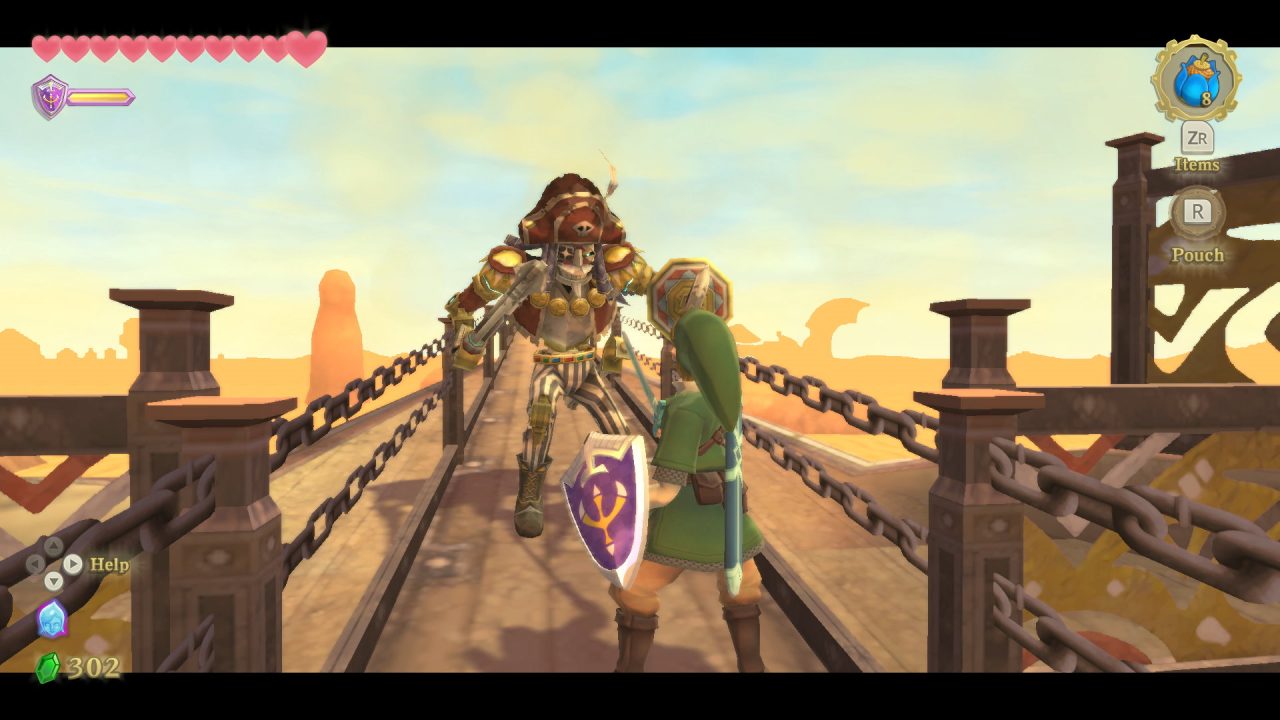
There was more fuss around Skyward Sword‘s all-in approach to motion controls. Up until HD, motion controls dictated every action on some level or another. The biggest element was, of course, the combat; swing one way, and Link swings similarly. Block and Link blocks accordingly. Sprain your wrist and watch the Hero of Skyloft stand idly and take a beating until you force yourself to press on or Fi reminds you that your batteries are low. Some loved it. Some hated it. I liked it; I just wished the game would let me play left-handed.
Skyward Sword HD eschews this mandatory handiness, offering multiple control schemes, including my personal favorite, the Switch Pro gamepad. I’ve tested HD‘s motion-controlled mode extensively, and I can happily say that the Joy-Cons freaked out on me far less than the notoriously unreliable Wiimote ever did, so the precision is (mostly) there in 2021. But Skyward Sword HD still feels best to me in a more traditional format, and that’s kind of a shame — swordplay was the #1 marketing gimmick behind the game, and now it’s a footnote. There’s no accounting for taste, however, so if you find yourself itching to wave your Joy-Cons in the air like you just don’t care, expect decent response times and modestly accurate slashes.
Exploration and The Legend of Zelda have almost always felt synonymous, and it is here that Skyward Sword HD falters the most. There simply isn’t as much joy in traversing the game’s long-lost Hyrule as can commonly be found in other Zelda titles. This is where that “irony of ironies” I mentioned earlier comes into play because, despite what I’ve just said, Hyrule is packed with puzzles, battles, and a sense of progression that owes itself directly to those puzzles and encounters.
Skyward Sword‘s level design, you see, is a mostly linear affair. Painfully linear, in fact. I’ve always admired the concept of an overworld that is as densely testy with me as any dungeon, where every corner hides something to be solved. But applying that philosophy to small clusters of open areas with obvious entrances and exits to the next bite-sized zone turns the whole thing into something of a mouse maze. Too often, I felt the prying gaze of Shigeru Miyamoto and Eiji Aonuma staring at me from high above, jotting down notes on how long it took me to discern the path to the Next Big Thing™.
This is exacerbated by the fact that you must traverse each smallish slice of the world multiple times. Locations do alter between story beats, mind you, making the retread a bit less irritating than some claim, but it still feels like something of a science experiment you’ve unwittingly signed up to endure. How many times did I step past that same patch of land? You know, the one with the nearby flower patch? Yeah, that one! Too. Many. Times.
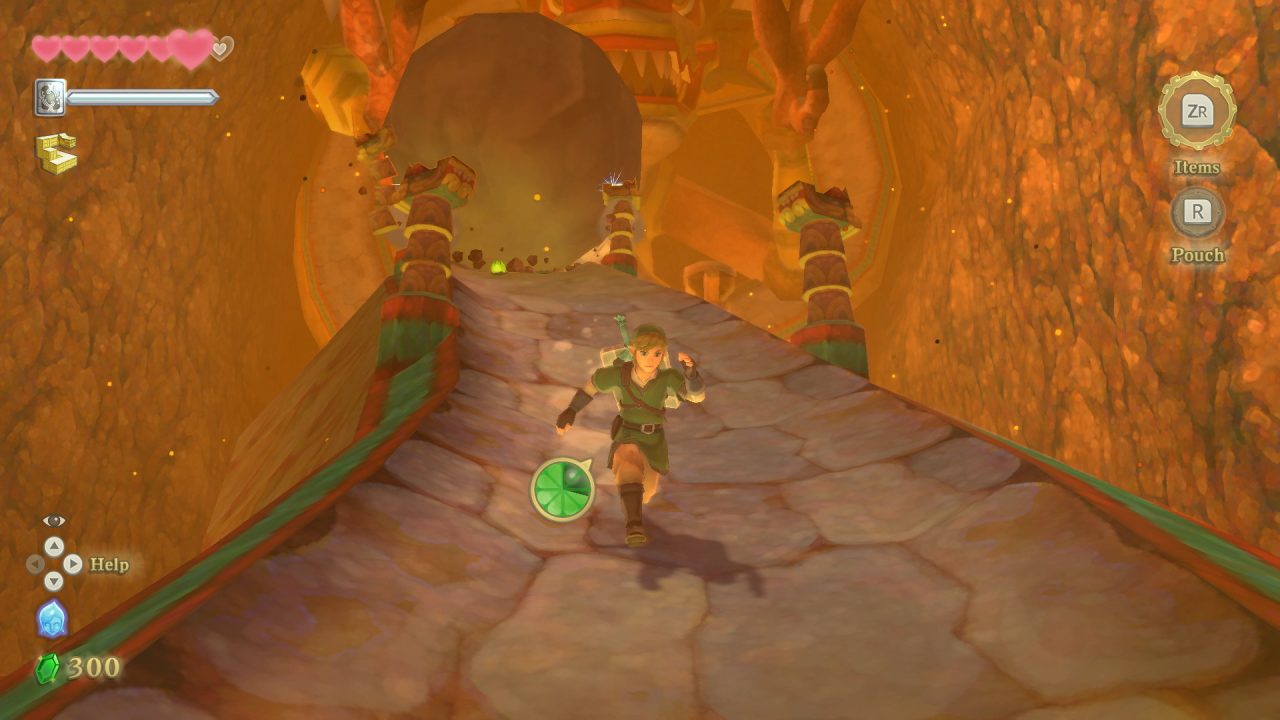
But perhaps I spoke too soon on the subject of ultimate ironies. One of Skyward Sword‘s saving gameplay graces — and something which Skyward Sword HD improves upon — is dungeon design. Such wicked strangeness that traveling the land so frequently makes me feel like a lab mouse, yet once I’m inside and solving full-blown puzzle after full-blown puzzle, the game comes alive with a spark of its own. It is as if Skyward Sword is a saga of inverse expectations. The sky world, despite a gathering of floating islands, is barren, wasted space. The surface world, despite savvy inhabitants and periodically thought-provoking moments, is overstuffed and stifling.
In contrast, the dungeons feel like a breath of fresh air. The strength of Skyward Sword‘s dungeon design is almost uniformly stellar. There are a few weaker entries — but the Fire Sanctuary is gorgeous, the Sandship employs one of the hippest gameplay mechanics in the series, and the Ancient Cistern is a master-class lesson in building a video game. I cannot overstate their richness, diversity, and powerful sense of accomplishment.
So how does Skyward Sword HD improve upon this? Three simple words: Fi shuts up. I’m not exaggerating when I say that far fewer interruptions from her is perhaps the remaster’s best quality. It would’ve been fine if this didn’t mean pausing the game to listen to her ad nauseam, and in dungeons, she used straight up tell you what to do more times than I care to count. Skyward Sword hails from that bizarre little Nintendo era in which they catered so hard to the “mainstream” that every premium title was jam-packed with “explanations.”
I was honestly surprised Fi never reminded me to brush my teeth after lunch.
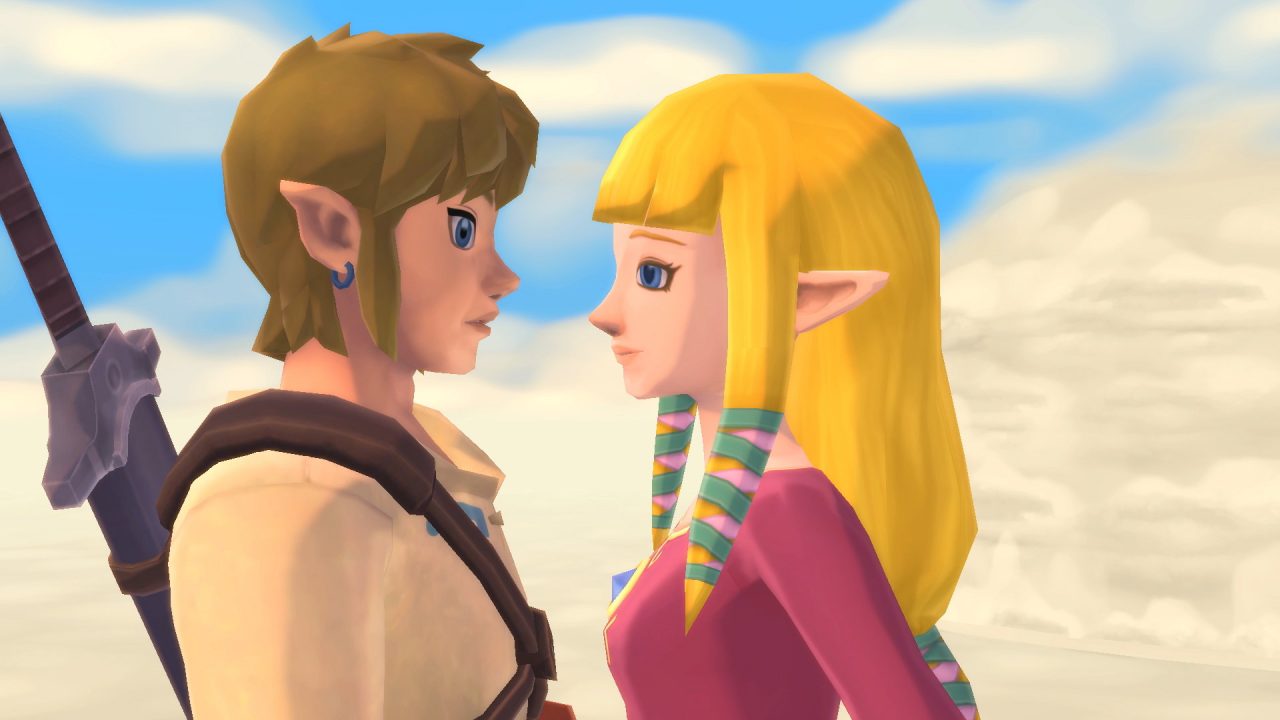
Boss fights, too, are mostly winners, even if their designs (Ghirahim and the final battle notwithstanding) leave something to be desired. They rarely reach the heights seen in entries like Twilight Princess. And yes, you still need to partake in one of them several times with minor alterations per encounter. But when they’re good, they’re more than good. “Take the good with the bad” ought to be Skyward Sword‘s fortune cookie catchphrase.
The good absolutely extends to the music of Skyward Sword, especially in crystalline HD quality. This game’s soundtrack has always been superb; from quiet scenes to rowdy ones, casual moments to blatantly romantic bits, and the coziness of Skyloft to the danger of Demise, there is nary a weak song to be found. Skyward Sword HD does just what it needed to do, enhancing the clarity without messing with the sound. I’ll proudly defend Breath of the Wild‘s more minimalist take. The piano from that game is stuck in my head forever, but pound for pound, Skyward Sword‘s soundtrack soars above not just Breath of the Wild but every other Zelda. That is, at least if you share my love for Koji Kondo, a very high bar to clear.
In some ways, The Legend of Zelda: Skyward Sword HD remains the warts-and-all divisive video game from 2011. Subpar and suffocating at its worst, but deeply moving and remarkably well-designed at its best, this is a game I’ll gladly replay every so often — but I may find myself gripping a glass of rum here and there. Though in other ways, Skyward Sword HD is precisely what the game needed in order to reach its full potential. The developers now trust us to figure things out on our own; they trust us to look first and ask questions later; to know when we feel like we need to take a break; to find our own fun rather than being told where to look.
Gaming enthusiasts whose time is too limited to sample every hot Nintendo classic might want to move along. However, those among us who can still devote ample hours to our favorite franchises (and can tolerate a few terribly repetitive angles) will find a lot to love here. That’s the most I could hope for from Skyward Sword HD, and indeed, it has delivered.



